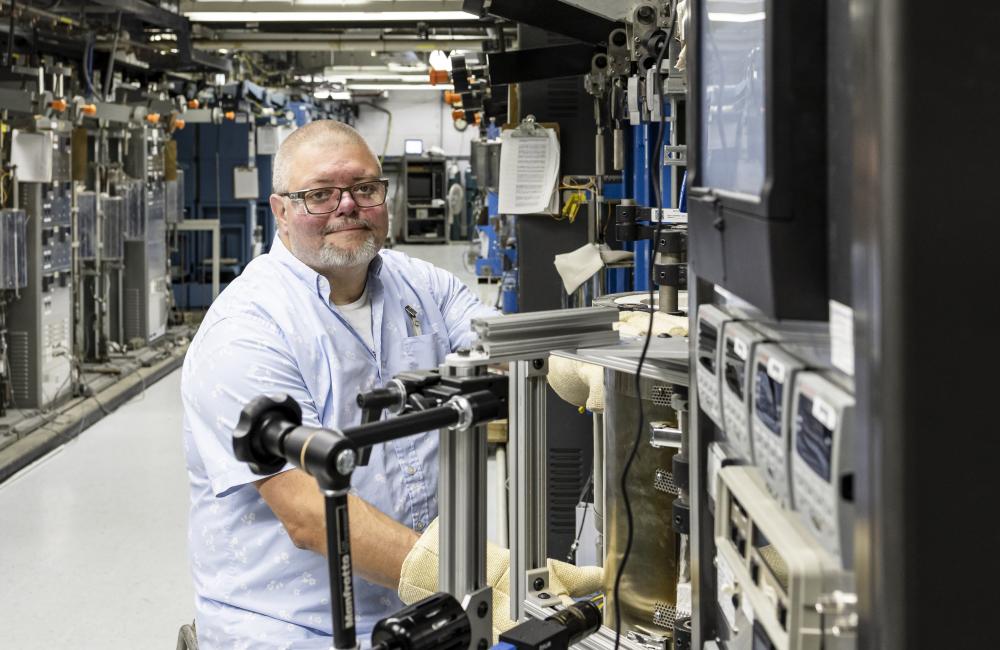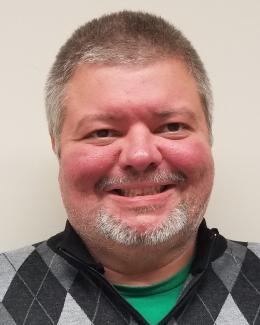Jeremy Moser, a technician in the Physical Sciences Directorate, is the go-to guy for pressure, or creep, tests on materials at ORNL. Credit: Genevieve Martin, ORNL/U.S. Department of Energy
Jeremy Moser is a go-to guy when you need to measure the creep properties of your next-generation alloy. That is because Moser, a mechanical engineer in the Department of Energy’s Oak Ridge National Laboratory, has been running creep tests on metals for almost 20 years.
Creep tests quantify the amount of deformation a material experiences when it is subjected to a constant stress and elevated temperature for an extended period of time. Scientists and engineers in academia, national laboratories and industry use the data from creep experiments to determine critical material properties that are essential for design, modeling, and materials selection in harsh operating conditions.
But Moser, in the Mechanical Properties and Mechanics group of the Materials Science and Technology Division at ORNL, recently developed a unique test specimen geometry and combined two experimental techniques, pressure testing typically performed on tubing, and traditional creep testing in tension. Coupling these experimental methods with the unique test specimen geometry allows the material’s creep behavior to be studied while the tube is controllably pressurized. In this way, the test specimen is subjected to a biaxial state of stress that more closely approximates the conditions that many components experience in service.
“It really gives you an idea what can happen,” Moser said. For example, water utility plants and nuclear power plants use pressurized steam, but the tubes or pipes have some creep in them, so they can pull apart as their walls get thinner over time, Moser explained. Combining tests helps identify those issues.
Moser recently received a New Capability Development Award from ORNL’s Physical Sciences Directorate for this work, with this certificate citation: “For accomplishments on turning two standard ‘old’ creep frames into systems with novel functionality of bi-axial creep testing with adjustable bi-axial stress ratios and full field creep strain measurements.”
In other words, Moser was innovative in his approach in providing researchers information they needed about the material’s creep behavior.
But that’s just one small part of what he does. Moser works with several different material testing systems and is intimately familiar with them all. Recently he started working with digital image correlation, or DIC, that provides data that can be plotted to precisely see the two-dimensional distributions of deformation of a pressurized region of a material.
“Normally when a specimen bursts, it makes a crack in the material. With DIC, we can focus on mapping the deformation as it happens and eventually leads to cracking,” he said.
He also is the Laboratory Space Manager, overseeing safety and ensuring all equipment is in working order. “Technicians at the lab have a lot of responsibilities,” he said. “I manage all the experiments in our lab, and I have to keep up with the pressure systems as well. There is a lot going on sometimes. Over the years, I’ve watched the technology advance. Keeping things running has been interesting.”
Recently Moser had an interesting piece of equipment that was not working: a World War II-era lathe that he found in the lab. It turned out it needed a new belt, which he replaced, although now it’s synthetic rubber and not leather, as the original.
Moser credits several people with his success. His supervisor now is Erik Herbert, the group leader. Yanli Wang, the lead researcher in the creep lab, helped direct him to the dual testing scheme. His first technician mentor was Robby Reed in the Mechanical Joining group, and L.D. Chitwood in the Corrosion Science and Technology group taught him vacuum systems.
“I’ve worked with so many PIs (principal investigators) it’s hard to remember them all, but Yanli Wang has given me the support and guidance that I thank her for it often,” he said.
Moser was born and raised in eastern Tennessee. He graduated Madisonville, now Sequoia, High School, and went on to receive an associate’s degree from Pellissippi State Community College in Knoxville while working in factories around the region. He then interned at ORNL in 2003 and was hired in 2005 with the Corrosion Science and Technology group. He went on to earn a bachelor’s degree in mechanical engineering.
He speaks with a pronounced Southern accent, which he feels has been a stigma. “People think you’re kind of ignorant when you have an accent like this,” he said.
But spend a few minutes talking with him and it’s clear that Moser, who is earning a master’s degree in mechanical engineering, is anything but.
A single father, Moser spends much of his time outside of work with his high school-age daughter and family in the area. The pair enjoy role playing video games and swimming in their pool, and he is often busy with “dad stuff.” When alone, he can be seen tending to his landscaping, growing wildflowers and succulents, and fussing with plants.
Once or twice a month Moser, a Southern Baptist, does jail ministry at the local prison. “I go in and talk to the prisoners and tell them about faith, and encourage them to change their lives,” he said. “I feel like I’m fulfilling a purpose.” And for once, without pressure.
UT-Battelle manages ORNL for DOE’s Office of Science, the single largest supporter of basic research in the physical sciences in the United States. DOE’s Office of Science is working to address some of the most pressing challenges of our time. For more information, visit https://energy.gov/science. —Lawrence Bernard



